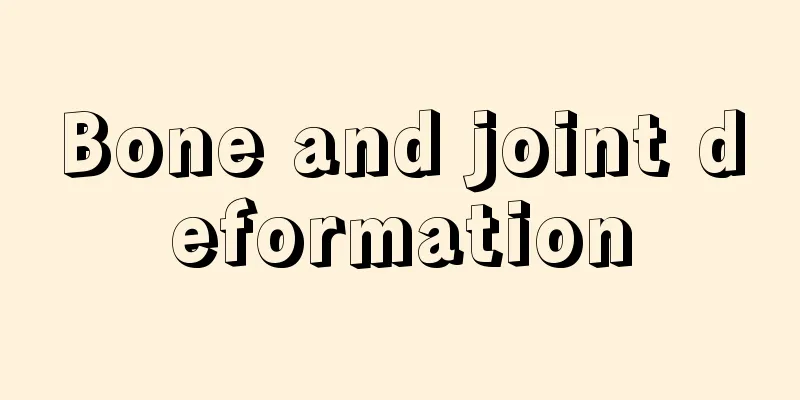Bone and joint deformation

|
We occasionally find that the legs of some elderly people are not particularly straight. Everyone has elderly people in their family, and I believe everyone must know the reason. Most of them are caused by bone and joint deformation. What causes bone and joint deformation and what are the symptoms? Please see below for the causes and manifestations of bone and joint deformation. Osteitis deformans refers to a chronic bone disease of unknown etiology, with progressive rheumatic bone and joint pain, spinal and limb deformities, pathological fractures, and symptoms of brain and spinal cord compression as the main manifestations. It is also called Paget's disease and osteitis deformans. Its incidence rate varies greatly by region, race, and age. It is more common in Western Europe, Australia, New Zealand and other regions, and is extremely rare in Africa and East Asia (including China). Both men and women can be affected, often occurring in people over 40 years old, and 15% have a family history. Clinical manifestations 1. Symptoms The disease has an insidious onset. The main symptoms are pain, stiffness, fatigue, bone deformities, headaches, hearing loss, and enlarged head. Paget's bone pain is deep, aching pain that is occasionally severe and may be worse at night. Pain may also be caused by nerve compression or be related to osteoarthritis, depending on the extent and location of the lesion, whether it is mono- or poly-bone, the presence or absence of deformity, and comorbidities. This disease often occurs in the axial skeleton, but can affect any bone. Common bone deformities among patients include enlarged head, hunchback and bent limbs. They may also experience basilar skull depression, compression of the spinal cord and nerve roots, otosclerosis, deafness and optic atrophy. Because bones are weakened, fractures can occur with minimal injury, most commonly in the femur, tibia, humerus, spine, and pelvis. 2. Physical signs The patient has enlarged skull bones in both temporal regions, visible forehead bulge, varicose veins on the scalp, unilateral or bilateral sensorineural deafness or otosclerosis, vascular striae in the fundus, and a short and hunchbacked torso, resembling an ape. The patient has a staggering gait, anterolateral bending of the thigh or calf, tenderness of the periosteum and increased skin temperature. Hearing loss, spinal cord stenosis, partial paralysis, or paraplegia are all signs of nerve compression. Paget's disease of bone is a metabolically active disease with severe vascular involvement, so high-output heart failure may occur. Bowing of long bones and osteoarthritis of adjacent joints may cause deformities. Pathological fracture occurs. Joint diseases Various bone and joint diseases, including degenerative arthritis, bursitis, synovitis, cervical spondylosis, lumbar spondylosis, frozen shoulder, bone hyperplasia, rheumatoid arthritis, rheumatoid arthritis, femoral head necrosis, etc., the root cause of the disease is not bone lesions. Modern medical research has found that the root cause lies in the loss of joint protection ability of the "joint protection system" such as cartilage. |
<<: How to treat cracking bones and joints all over the body
>>: The dangers of sucking empty milk bottles
Recommend
Liquid-based cytology testing is the best method for early detection of cervical cancer
Cervical cancer is one of the most common maligna...
What should I do if I have a mouth full of oral ulcers? Do these things well
Oral ulcers, also known as mouth sores, are an ul...
How to remove paint from clothes
For friends who are engaged in interior decoratio...
What is the mediastinal lymph node
Mediastinal lymph nodes are a clinical infectious...
How to drink red wine, the benefits of drinking red wine
How to Taste Wine 1. Look. Tilt the wine 45 degre...
What are the postoperative examination items for endometrial cancer? These four examinations are required
Endometrial cancer is more likely to occur in mid...
What should I do if my baby wakes up as soon as I put him down?
Parents often hold their babies in their arms unt...
Things to note and taboos for moving to a new house
Moving is always inevitable in life. Sometimes yo...
What should be paid attention to in routine nursing after lung cancer surgery? 4 things to pay attention to after lung cancer surgery
Lung cancer is a malignant disease. The earlier i...
The difference between an air fryer and an oven
Air fryer is a new method of cooking using vacuum...
Characteristics of urine routine in bladder cancer
The most likely thing for bladder cancer patients...
How to treat early lung cancer? Four things that patients with early lung cancer must know
With the acceleration of the pace of life and the...
Transmission routes of uterine cancer
There are many friends around us who suffer from ...
How to choose a pillow
Many people say that besides people, the most imp...
Common melanoma diagnosis methods
As social pressure increases and people's wor...









